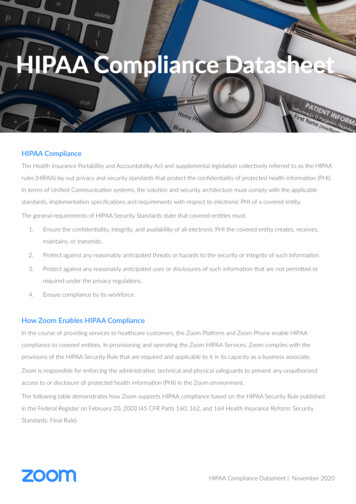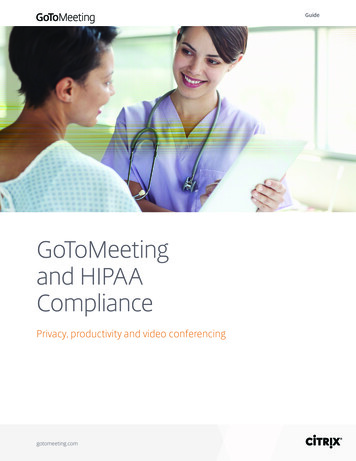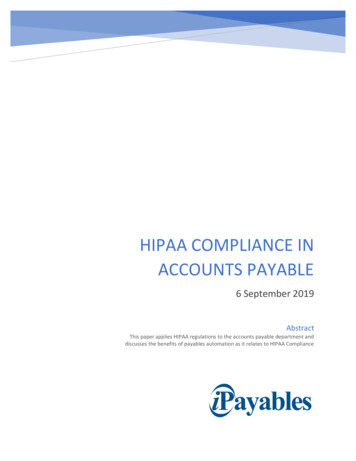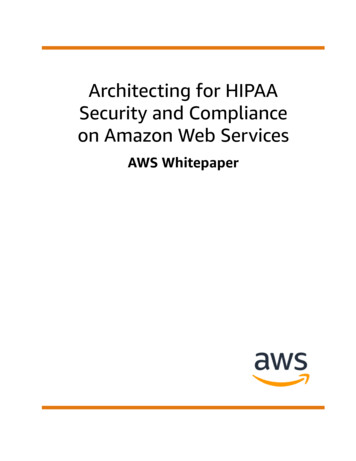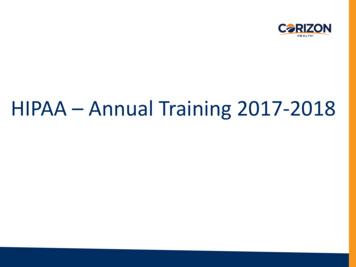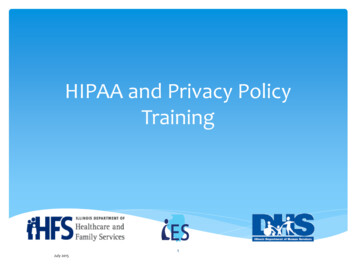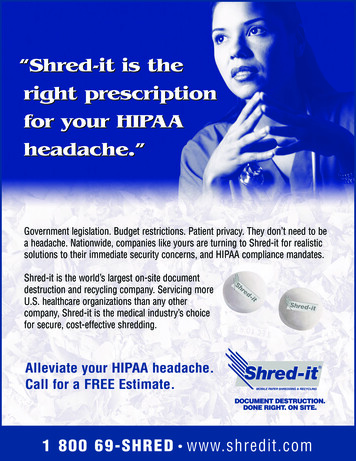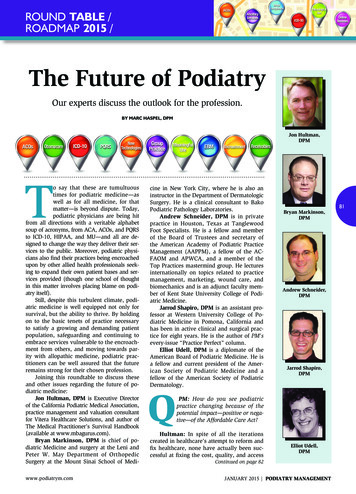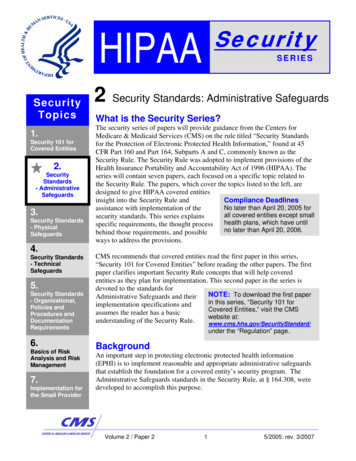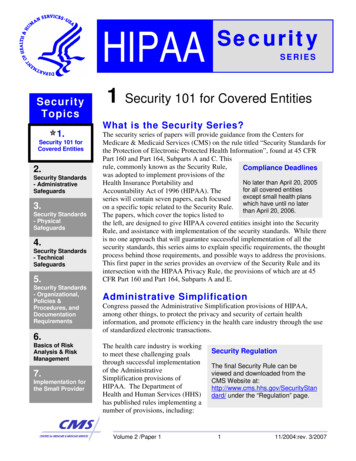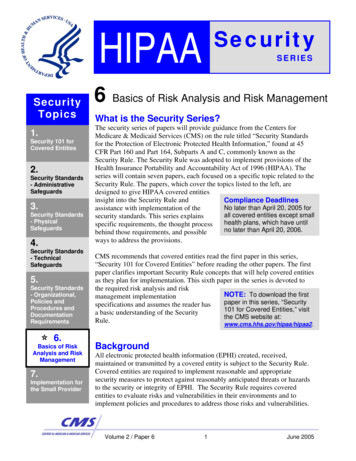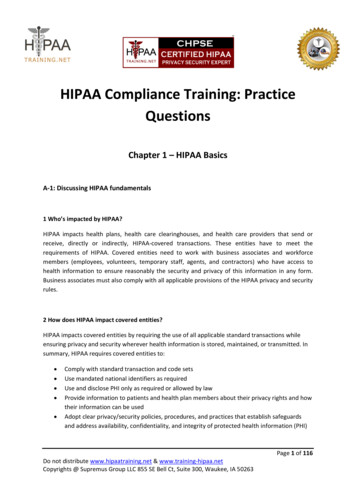
Transcription
HIPAA Compliance Training: PracticeQuestionsChapter 1 – HIPAA BasicsA-1: Discussing HIPAA fundamentals1 Who’s impacted by HIPAA?HIPAA impacts health plans, health care clearinghouses, and health care providers that send orreceive, directly or indirectly, HIPAA-covered transactions. These entities have to meet therequirements of HIPAA. Covered entities need to work with business associates and workforcemembers (employees, volunteers, temporary staff, agents, and contractors) who have access tohealth information to ensure reasonably the security and privacy of this information in any form.Business associates must also comply with all applicable provisions of the HIPAA privacy and securityrules.2 How does HIPAA impact covered entities?HIPAA impacts covered entities by requiring the use of all applicable standard transactions whileensuring privacy and security wherever health information is stored, maintained, or transmitted. Insummary, HIPAA requires covered entities to: Comply with standard transaction and code setsUse mandated national identifiers as requiredUse and disclose PHI only as required or allowed by lawProvide information to patients and health plan members about their privacy rights and howtheir information can be usedAdopt clear privacy/security policies, procedures, and practices that establish safeguardsand address availability, confidentiality, and integrity of protected health information (PHI)Page 1 of 116Do not distribute www.hipaatraining.net & www.training-hipaa.netCopyrights @ Supremus Group LLC 855 SE Bell Ct, Suite 300, Waukee, IA 50263
Train workforce members so that they understand the organization’sprivacy/security policies, procedures, and practicesDesignate a privacy official and a security official (may be the same person) to beresponsible for seeing that privacy/security compliance is met and continues to be metSecure patient and health plan member individually identifiable health information so it isn’treadily available to those who don’t need itImplement policies, procedures, and practices that reasonably ensure that only theminimum amount of PHI is shared when needed to conduct the business of health careEnsure that patients and health plan members can exercise their rights regarding access to,amendment of, restriction of, use of, etc., their health informationFollow breach assessment protocols when inappropriate disclosures occur and applyappropriate sanctions in all casesDocument all compliance activities, policies, procedures, plans and actionsComply with all federal audits and investigationsBusiness associates are subject to many of the same requirements, although they are not requiredto comply with standard transactions unless their business function involves transactions. Businessassociates also tend to have little to no direct contact with patients for treatment purposes, so manyof the individual rights provisions are less likely to apply. However, all provisions of the Security Ruleand key elements of the Privacy Rule, such as adhering to appropriate uses and disclosures and tominimum necessary, are required for business associate compliance.3 Outline the general HIPAA timelines for compliance.The final HIPAA rules and regulations provide covered entities and business associates a specifiedperiod of time to reach compliance with the new provisions. Each published rule contains a timelineor timelines for compliance, with small health plans normally given a longer time to comply. Whiledifferent provisions often have different time periods for coming into compliance, due dates aregenerally becoming shorter over time as the industry is expected to be fully in compliance at thetime of the publication of new rule changes.As HIPAA continues to evolve and provide more specific requirements and guidance, it is helpful tobe aware of how rapidly changes to rules must be implemented. While the standard timeline isnormally 180, the published timeline for each rule is the ultimate deadline, Enforcement provisionsare usually immediately effective for any violations that occur after the final rule publication date.4 Imagine that you’re describing HIPAA’s core requirements and impact to a client. Summarize theimpact HIPAA has on businesses in the health care industry.Page 2 of 116Do not distribute www.hipaatraining.net & www.training-hipaa.netCopyrights @ Supremus Group LLC 855 SE Bell Ct, Suite 300, Waukee, IA 50263
Standardizes electronic, administrative, and financial health care transactionsCreates unique health identifiers for employers, health plans, and health care providers,(likely not individuals)Sets industry security standards protecting the availability, confidentiality, and integrity ofindividually identifiable health informationEnsures the privacy of protected health information with specific rules around howprotected information can be used and sharedRequires ongoing compliance project management, execution, testing, training, etc.Requires ongoing investment (staff, technology, resources, and fiscal) to maintain continuedprivacy and security compliance5 Which of the following are examples of health care providers?A PhysiciansB Billing servicesC HospitalsD Medical reviewersE HMOsF DentistsG Pharmacies6 What’s a health care clearinghouse? Give some examples.Healthcare clearinghouses are organizations that process health care transactions on behalf ofproviders and insurers. Examples include: Billing servicesRepricing companiesMedical reviewersCommunity health management information systemsValue added networksSwitchesPage 3 of 116Do not distribute www.hipaatraining.net & www.training-hipaa.netCopyrights @ Supremus Group LLC 855 SE Bell Ct, Suite 300, Waukee, IA 50263
B-1: Discussing Administrative Simplification1 Let’s say your client wants to understand HIPAA Administrative Simplification standards better.What are the key standards and supporting standards that were adopted?The Administrative Simplification standards include: Standards for Electronic Transactions, Code Sets, and IdentifiersStandards for Privacy of Individually Identifiable Health Information (otherwise known asprotected health information or PHI)Administrative, Physical, and Technical Security StandardsSupporting standards include: Standards for Code SetsNational Standards for Identifiers2 Why is HIPAA primarily about e-business initiatives within an organization?Because health care business applications include a variety of functions such as patient scheduling,registration, clinical reporting, billing, and health insurance claims, which, when automated andseamlessly integrated, can improve both patient care and the bottom line. Healthcare businessapplications are also involved in the storage and movement of medical and claims information. TheAdministrative Simplification subtitle specifies standards for the electronic transmission of manycommon administrative and financial transactions previously performed on paper or usingnonstandard electronic transactions. In addition, standards for protecting the privacy and security ofpatient and health plan member health information in electronic form are essential in an automatedbusiness environment.To comply with HIPAA, all health care business applications must be secure and integrated into thehealth organization’s security infrastructure. These standards are the launch pad for e-businessinitiatives in health care. The HIPAA privacy rule, though, provides protections against inappropriatedisclosure and use of PHI in any form, not just electronic.3 After listening to a quick executive overview of HIPAA basics, your client asks for examples ofsome specific and relevant transactions. What might you include in this list of examples?Page 4 of 116Do not distribute www.hipaatraining.net & www.training-hipaa.netCopyrights @ Supremus Group LLC 855 SE Bell Ct, Suite 300, Waukee, IA 50263
A transaction amounts to the exchange of information between two parties to carry outcommon health care financial or administrative activities. Current transactions exist for the followingtypes of information exchanges: Health claims or equivalent encounter informationHealthcare payment and remittance adviceCoordination of benefitsHealth claims statusEnrolment and disenrollment in a health planEligibility for a health planHealth plan premium paymentsReferral certification and authorizationOther transactions that the Secretary of HHS may prescribe by regulation4 Identify some key technology components of a secure infrastructure for a health careorganization. FirewallsIntrusion Detection Systems (IDS)Secure Virtual Private Networks (VPNs)Secure MessagingBiometricsSmart cardsAuthentication tokensAntivirus and antispyware applicationsSecure web sitesDigital signaturesMedia encryption softwareMobile device securityCloud computingC-1: Discussing HIPAA penalties1 What type of penalties does HIPAA set for noncompliance?Page 5 of 116Do not distribute www.hipaatraining.net & www.training-hipaa.netCopyrights @ Supremus Group LLC 855 SE Bell Ct, Suite 300, Waukee, IA 50263
HIPAA established civil and criminal penalties for noncompliance. Civil penalties take theform of monetary fines. Criminal penalties may take the form of monetary fines and/orimprisonment.2 Give some examples of criminal penalties under HIPAA.Criminal penalties are: Up to 50,000 and one year in prison for obtaining or disclosing protected healthinformationUp to 100,000 and up to five years in prison for obtaining protected health informationunder false pretencesUp to 250,000 and up to ten years in prison for obtaining or disclosing protected healthinformation with the intent to sell, transfer, or use it for commercial advantage, personalgain, or malicious harm3 What’s the civil monetary penalty for violating transaction standards?The civil monetary penalty for violating transaction standards is up to 50,000 per violation and upto 1.5 million per violation of a single standard per calendar year.4 What’s the penalty for misuse with intent to sell, transfer, or use identifiable healthinformation?If misuse is with intent to sell, transfer, or use individually identifiable health information forcommercial advantage, personal gain, or malicious harm, a fine of 250,000 and/or imprisonment ofnot more than ten years.D-1: Discussing HIPAA-related organizations1 What’s the target audience of the NCPDP?The NCPDP’s target audience includes the pharmacy services sector of the health care industry. Thisincludes organizations such as:Page 6 of 116Do not distribute www.hipaatraining.net & www.training-hipaa.netCopyrights @ Supremus Group LLC 855 SE Bell Ct, Suite 300, Waukee, IA 50263
Pharmacy chainsDatabase management organizationsPharmaceutical manufacturersTelecommunication and systems vendorsWholesale drug distributorsPharmacy benefit managers2 What do WPC published Implementation Guides address?These guides generally address industry-specific or company-specific EDI implementation issues andoften include explanatory front matter, figures, examples, and cross-references.3 Describe the NCVHS organization. How is the NCVHS involved with the HIPAA ASCA?The National Committee on Vital and Health Statistics (NCVHS) is an advisory committee to theSecretary of Health and Human Services. The HIPAA Administrative Simplification Compliance Act(ASCA) requires that a sample of compliance plans be provided to NCVHS.4 What’s the purpose of a DSMO? Give some examples of specific DSMOs.The Secretary of HHS named six organizations to maintain standards using criteria specified in theRules defined. These organizations are referred to as Designated Standards MaintenanceOrganizations (DSMOs). They are: ANSI Accredited Standards Committee (ASC) X12Dental Content Committee of the American Dental AssociationHealth Level Seven (HL7)National Council for Prescription Drug Programs (NCPDP)National Uniform Billing Committee (NUBC)National Uniform Claim Committee (NUCC)E-1: Discussing HIPAA terminologyPage 7 of 116Do not distribute www.hipaatraining.net & www.training-hipaa.netCopyrights @ Supremus Group LLC 855 SE Bell Ct, Suite 300, Waukee, IA 50263
1 Let’s say your client wants a better understanding of exactly what constitutes coveredentities under HIPAA statute and rule. Describe the scope of covered entities under HIPAA.The regulations place specific obligations upon covered entities. Covered entities include healthplans (including most employer-sponsored group health plans), health care clearinghouses, and anyhealth care provider who transmits protected health information using a HIPAA-defined standardtransaction directly or indirectly. Business associates are also governed by and subject to many ofthe same obligations under HIPAA as covered entities.Most health care providers use electronic transmission in some form or another when processingclaims or in their financial dealings with health plans, such as Medicare or commercial plans. In thesecases, the HIPAA statute and rules apply to these health care providers.2 What’s a health care clearinghouse?A health care clearinghouse is an entity that performs the functions of format translation and dataconversion to and from HIPAA standard transactions, generally on behalf of a health plan or aprovider. When engaged in these activities, a billing service company, repricing company,community health management information system, community health information system, orvalue-added networks and switches, would be considered a health care clearinghouse.3 Give some examples of identifiers within health information that constitute personallyidentifiable information? The individual’s nameCity or county where the individual livesZip CodeSocial Security numberFinger printTelephone numberMedical record number or fax numberE-mail address4 What is a trading partner agreement?A trading partner agreement is an agreement between two covered entities, usual
Questions Chapter 1 – HIPAA . (ASCA) requires that a sample of compliance plans be provided to NCVHS. 4 What’s the purpose of a DSMO? Give some examples of specific DSMOs. The Secretary of HHS named six organizations to maintain standards using criteria specified in the Rules defined. These organizations are referred to as Designated Standards Maintenance Organizations (DSMOs). They
